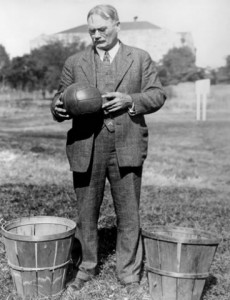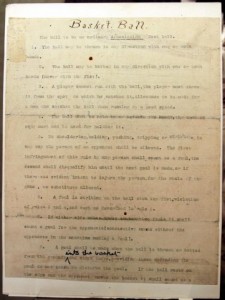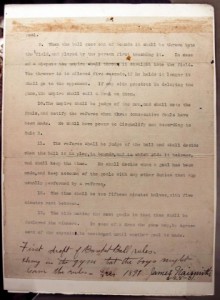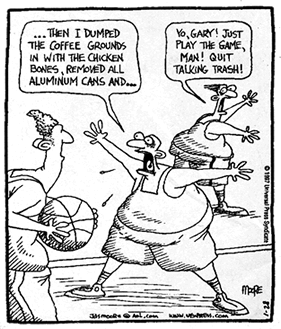13 Rules, the birth of basketball
 Have a couple mil laying around for a really cool Christmas present? That’s what is expected as the minimum bid for the original 13 rules of basketball, written in less than an hour by the father of basketball, James Naismith (left), on December 21, 1891. The typewritten rules, first hung outside the gym at a Springfield YMCA in Massachusetts, go on the auction block on December 10 to raise money for the Naismith International Basketball Foundation, which promotes sportsmanship and provides services to underprivileged youths around the world.
Have a couple mil laying around for a really cool Christmas present? That’s what is expected as the minimum bid for the original 13 rules of basketball, written in less than an hour by the father of basketball, James Naismith (left), on December 21, 1891. The typewritten rules, first hung outside the gym at a Springfield YMCA in Massachusetts, go on the auction block on December 10 to raise money for the Naismith International Basketball Foundation, which promotes sportsmanship and provides services to underprivileged youths around the world.
Naismith, who died in 1939 — three years after basketball became an Olympic sport — would hardly recognize the game as it is being played today, especially at the professional level (see Rule No. 5). However, some of the concepts of the original rules are still in force, such as the five-second in-bound rule, traveling and fouling, although in the original rules, three consecutive fouls by the opposing team earned you a bucket. Some of the other fundamental elements of the game, such as the number of players on the floor, dribbling and free throws, developed over time.
The game continues to evolve with principle changes, such as the addition of the three-point shot, and in the NBA — because you have to keep those high-priced players on the floor (some who could pay for these original rule documents a hundred times over) — six fouls instead of five before you’re out of the game.
One of the most interesting of the 13 rules was No. 9, which stated that whichever team got to an out-of-bounds loose ball first also got possession. That must have made for some crazy scrambles outside the field of play, especially if there wasn’t much space between the sidelines and the wall.
The first basketball game was played at that Massachusetts YMCA by a group of 18 men — some with beards and mustaches — who all played on the floor at the same time in teams of nine men each. According to memoirs by Naismith, “they made a great many fouls at first; and as a foul was penalized by putting the offender on the side lines until the next goal was made, sometimes half of a team would be in the penalty area.”
After that first experiment and as the men became more enamored with the sport, word got around that there was a fun and interesting new game being played at the YMCA. Teachers from a nearby grade school started coming by to watch daily games, and those teachers were the first to ask why the game couldn’t be played by girls. Naismith said he didn’t see why not, and those teachers organized the first ever girls basketball team.
Here are the original rules for the game — that was to be played with “an ordinary Association football” (soccer ball) — written 119 years ago this December:
 1. The ball may be thrown in any direction with one or both hands.
1. The ball may be thrown in any direction with one or both hands.
2. The ball may be batted in any direction with one or both hands (never with the fist).
3. A player cannot run with the ball. The player must throw it from the spot on which he catches it, allowance to be made for a man who catches the ball when running at a good speed if he tries to stop.
4. The ball must be held in or between the hands; the arms or body must not be used for holding it.
5. No shouldering, holding, pushing, tripping, or striking in any way the person of an opponent shall be allowed; the first infringement of this rule by any player shall count as a foul, the second shall disqualify him until the next goal is made, or, if there was evident intent to injure the person, for the whole of the game, no substitute allowed.
6. A foul is striking at the ball with the fist, violation of Rules 3,4, and such as described in Rule 5.
7. If either side makes three consecutive fouls, it shall count a goal for the opponents (consecutive means without the opponents in the mean time making a foul).
 8. A goal shall be made when the ball is thrown or batted from the grounds into the basket and stays there, providing those defending the goal do not touch or disturb the goal. If the ball rests on the edges, and the opponent moves the basket, it shall count as a goal.
8. A goal shall be made when the ball is thrown or batted from the grounds into the basket and stays there, providing those defending the goal do not touch or disturb the goal. If the ball rests on the edges, and the opponent moves the basket, it shall count as a goal.
9. When the ball goes out of bounds, it shall be thrown into the field of play by the person first touching it. In case of a dispute, the umpire shall throw it straight into the field. The thrower-in is allowed five seconds; if he holds it longer, it shall go to the opponent. If any side persists in delaying the game, the umpire shall call a foul on that side.
10. The umpire shall be judge of the men and shall note the fouls and notify the referee when three consecutive fouls have been made. He shall have power to disqualify men according to Rule 5.
11. The referee shall be judge of the ball and shall decide when the ball is in play, in bounds, to which side it belongs, and shall keep the time. He shall decide when a goal has been made, and keep account of the goals with any other duties that are usually performed by a referee.
12. The time shall be two 15-minute halves, with five minutes’ rest between.
13. The side making the most goals in that time shall be declared the winner. In case of a draw, the game may, by agreement of the captains, be continued until another goal is made.
More:
- Original rules of basketball go to auction Dec. 10 – Associated Press
- Naismith’s Rules of Basketball to Be Auctioned – NYTimes.com
- Read online: Basketball – It’s Origin & Development, by James Naismith – Google Books



You must be logged in to post a comment.